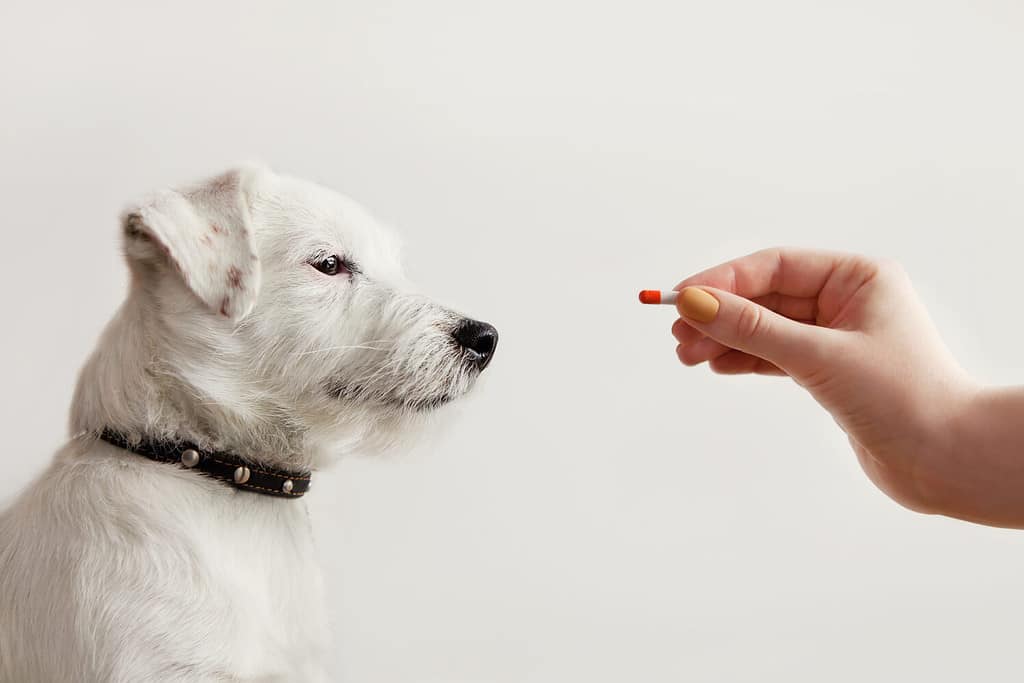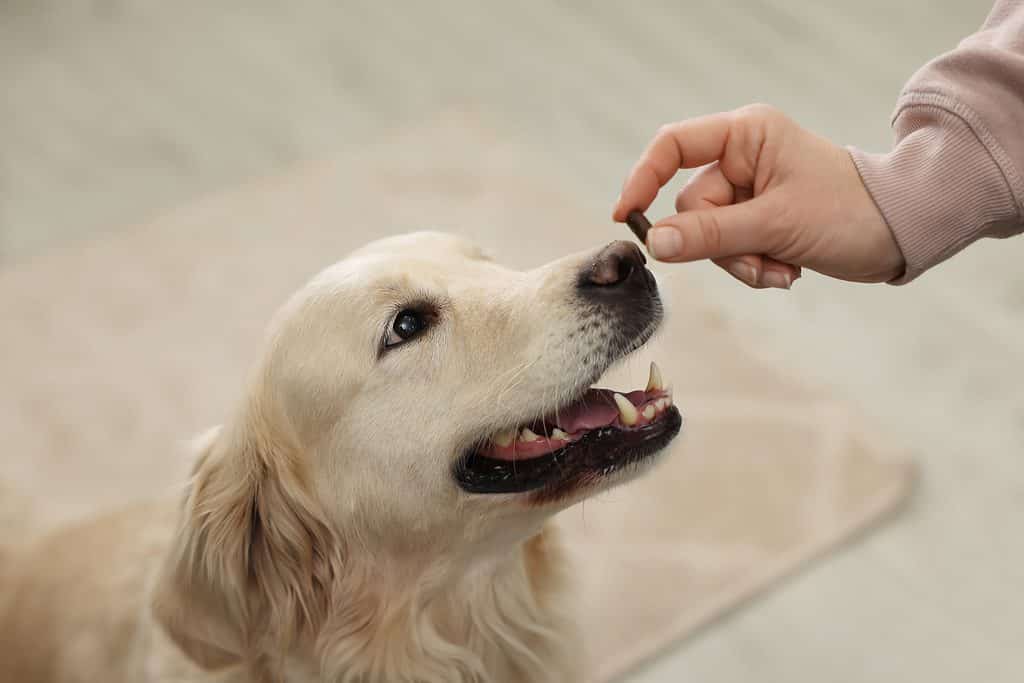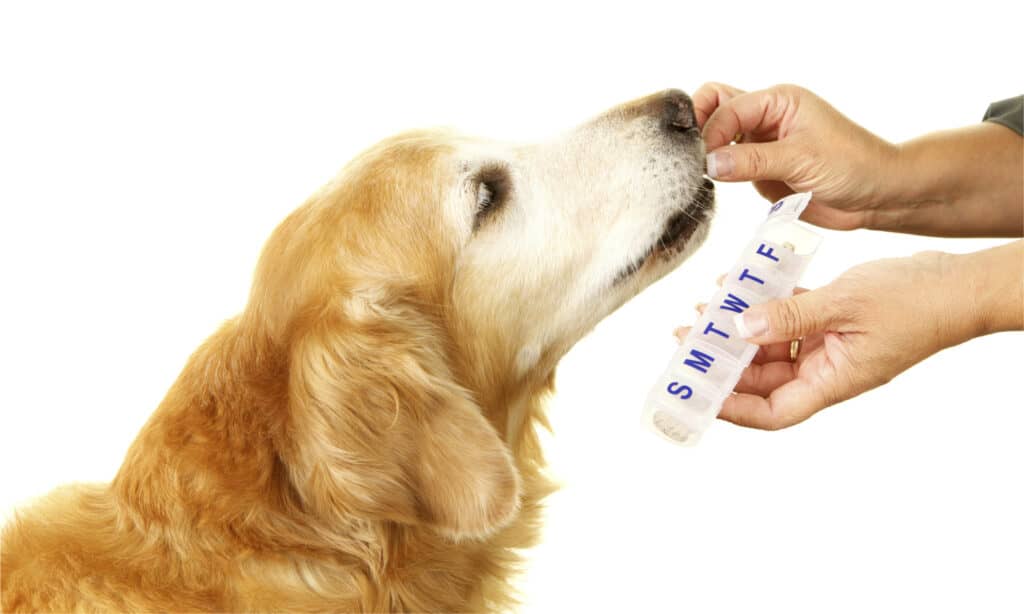Has your veterinarian prescribed Galliprant to your dog with painful arthritis? You likely have questions about this popular medication and how it works, so let’s break down everything you need to know about Galliprant below!
What Is Galliprant?

Galliprant was designed to manage the pain associated with arthritis in dogs.
©Liudmyla Guniavaia/Shutterstock.com
Galliprant is an NSAID that was created specifically to manage painful arthritis in dogs. Unlike other NSAIDS, Galliprant was designed for long-term use.
Standard NSAIDs work by suppressing prostaglandin production in the body, as this is a chemical released from inflamed tissues. However, while this is effective in managing inflammation, it can lead to blood clots, constricted blood vessels, and even GI complications over time. Because Galliprant does not target prostaglandins like other NSAIDS, dogs can be on this medication long-term with minimal risks.
Is Galliprant Safe For Dogs?
Galliprant is safe for use in dogs when following your veterinarian’s instruction for administration. It is also only safe in the dose and form that your veterinarian prescribes, as high doses of the medication can lead to health complications in some canine friends.
While Galliprant is an NSAID, it’s important to note that you should not offer your dog any forms of human NSAIDs. Human NSAIDs can cause health complications ranging from gastrointestinal bleeding to kidney injury. Galliprant is an NSAID that was created specifically for use in dogs.
Why Do Dogs Take Galliprant?

Studies show that arthritis is the number one cause of chronic pain in dogs, and it’s even a common factor behind many euthanasias.
©New Africa/Shutterstock.com
Galliprant was designed to help dogs with painful arthritis. Osteoarthritis is a chronic condition that often worsens over time, so Galliprant can help to maintain a dog’s quality of life as they age with this joint disease. Studies show that arthritis is the number one cause of chronic pain in dogs, and it’s even a common factor behind many euthanasias. This is why Galliprant is such an important medication!
Dr. Amy Nicole Lewis, a veterinarian with Worldwide Veterinary Services told A-Z Animals that osteoarthrosis can deeply impact a dog’s quality of life. Many assume that dogs get used to the chronic pain they experience with arthritis, but this is not the case at all. Dogs with arthritis are proven to become more sensitive to the pain over time.
Some of the symptoms that Galliprant can help to manage in dogs includes:
- Joint stiffness
- Difficulty getting up and down
- Limping
- Decreased range of motion
- Muscle wasting
- Hind limb weakness
- Leg pain
- Irritability
Galliprant can also be used alongside joint supplements. Your vet will determine the best treatment package for your canine friend.
How Do I Give My Dog Galliprant?
Galliprant is a chewable tablet that is usually given once daily. Unlike many other medications that require food upon administration, Galliprant needs to be given on an empty stomach. Galliprant will not absorb into the body properly when there is food in your dog’s stomach.
What Is The Dose Of Galliprant In Dogs?
Before we offer the standard dose of Galliprant for dogs, we should say again that you should never give your dog Galliprant without veterinary approval. With that in mind, there is a standard Galliprant dose that most veterinarians follow.
The standard dose for Galliprant in dogs is 0.9 mg per pound of body weight. It should be given once every 24 hours on an empty stomach, and it is typically prescribed for long-term use. If you ever miss your pet’s Galliprant dose, it’s best to skip the dose altogether and resume their standard dosing schedule the next day. Do not give your dog extra or double Galliprant doses.
Does Galliprant Have Any Side Effects In Dogs?

The standard dose for Galliprant in dogs is
0.9 mg per pound of body weight.
©Donna Ellen Coleman/Shutterstock.com
Galliprant is a safe mediation used to manage arthritis in dogs, but just like any other prescription medication, it can cause a few minor side effects. Some of the most common side effects with Galliprant use in dogs include:
- Decreased appetite
- Lethargy
- Vomiting
- Diarrhea
We suggest reaching out to your vet if your dog develops any of the side effects we mentioned above. Your vet may be able to adjust your dog’s dose to relieve their side effects. Your vet may also recommend periodic blood testing to make sure your dog is tolerating the medication well.
How Do I Get Galliprant For My Dog?
Galliprant is an NSAID that was created to manage painful arthritis in dogs. Galliprant was designed for long-term management of inflammation, so the medication is perfect for chronic osteoarthritis. Galliprant is a mediation that can only be purchased at your vet’s office. We suggest reaching out to your veterinary team if you think your dog can benefit from the use of Galliprant.
The photo featured at the top of this post is © Jaromir Chalabala/Shutterstock.com
Ready to discover the top 10 cutest dog breeds in the entire world?
How about the fastest dogs, the largest dogs and those that are -- quite frankly -- just the kindest dogs on the planet? Each day, AZ Animals sends out lists just like this to our thousands of email subscribers. And the best part? It's FREE. Join today by entering your email below.
Thank you for reading! Have some feedback for us? Contact the AZ Animals editorial team.







